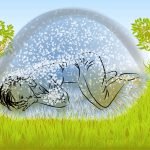The Path of Human Development
Paul Theriault, ND
From the earliest writings of homeopathy, it has been observed that homeopathic treatment has an effect on one’s spiritual development. In Aphorism 9 of the Organon,1 Hahnemann states:
In the healthy human state, the spirit-like life force (autocracy) that enlivens the material organism as dynamis, governs without restriction, and keeps all parts of the organism in admirable, harmonious, vital operation, as regards both feelings and functions, so that our indwelling, rational spirit can freely avail itself of this living, healthy instrument for the higher purposes of our existence.
Clinically, almost every homeopath has observed the beautiful mental and spiritual transformations and growths that have occurred under the influence of well-selected remedies. States of increased inner peace, joy, relief of long-held delusions or traumas, increased insight, and greater connection to one’s chosen spirituality have all been commonly reported in the homeopathic literature; however, the question of how homeopathy affects spiritual development, and what precisely constitutes spiritual development, has yet to be fully explored.
Much of the knowledge holistic practitioners have obtained of human physiology has been gained by the observation of healing processes. Hering’s Law, Reckeweg’s Disease Progression, Channel Theory of Chinese Medicine,2 and Emunctorology in Naturopathic Medicine3 all originate in the systematic observation of the healing responses of patients. Our observations of these healing responses can be used in a similar way to chart the process of spiritual development as patients experience it.
Layers of Personal Development
This has already been done by 1 individual homeopath, Tinus Smits. While best known for his initial development of CEASE therapy,* Smits is also the originator of a system of polycrests (outlined in the book Inspiring Homeopathy), each of which address a particular phase of development which Smits believed was shared by all humanity.4 Most fascinatingly, Smits also posited that people did not stay within the sphere of 1 remedy for life (the constitutional approach). In innumerable cases, he noted that patients, over a period of years, would move from 1 to another in a general order, advancing and becoming more spiritually aware as they gradually became healthier. Simultaneously, Jan Scholten developed his schema periodic table of the elements,5 positing a series of stages of evolution through which humans moved. Clinically, many practitioners, including myself, have noted that patients tend to move both down and to the right of the periodic table over time.
Recently, another author, Michal Yakir, also discovered a structure identical to that of both Smits and Scholten in the plant kingdom.6 I have also uncovered a similar structure in the animal kingdom, which I am currently exploring.7
All of these discoveries strongly parallel one another, pointing to the existence of a schema for human development which appears to permeate structures of the natural world, repeating itself over and over in slightly different flavors in a number of situations, such as monocot or dicot plants, minerals, and animal phyla. I have adopted Tinus Smit’s characterization of these different phases of development as layers.
Layer 1
The first layer involves the creation of a form for the being to inhabit. It is still united with the undifferentiated consciousness from which it emerged, and lacks a separate sense of identity. A close connection to the realm before life is apparent. The being in this layer is unsure of its position relative to both the physical world and life before life. Is it truly in the physical world, or is it in the life before life? More importantly, does the being want to be in the physical world?
There is a great deal of lightheadedness, floating, and absence. The being has not committed fully to life, and is therefore not fully in its body. Many report feelings of being invisible, and of others not noticing them. In extreme situations, the being may retreat to an out-of-body state when faced with difficulties.
Beings stuck in this layer have a very undeveloped sense of self. There are no borders with the outside world, but the being usually cannot respond in any way. They simply experience the outside world and are immensely pained. Many of the issues of beings stuck in this layer have to do with a desire to incarnate, but lacking the circumstances to do so.
Beings who have completely passed through this layer will be fully present in their bodies and in their lives, whatever the circumstances. Retreating and going out of body will not be a strategy they use. Exceptions, of course, occur when the being is subjected to intense trauma.
Layer 2
In the second layer, the being begins the process of separating fully from the divine. It now must go about the process of building a separate sense of self, fully distinct from the divine from which it came. This process is often described in patients’ language as the building of a barrier around the self, keeping the self and the external world separate.
The process of separation from the divine is a terrible one for many beings. One goes from being connected to all of existence, free and limitless and immense, to being trapped in a finite human body, small, alone, and powerless. There is great confusion over where one begins and others end. The self is often mixed up with others, and one identifies with the family, relationship, culture, country, or company.
Before a being’s barrier is fully constructed between itself and the outside world, the being is subject to the full unmitigated force of the external world. However, the being is capable of reacting to protect itself here, at least partially. The nature of this attempt to protect the self is often the key to identifying the remedy needed in any particular patient.
We see beings who attach themselves to others outside of themselves. There is a great deal of codependency, due to a lack of boundaries. We also see great narcissism; these are beings that also have no boundaries and who use that to manipulate those around them. Beings will also attach themselves to institutions or ideologies, being unable to distinguish between the institutions’ ideas and their own. The being becomes rigid and demands the external world to order itself according to their perceptions of what should and should not be.
Beings who have fully passed through this layer feel a distinct separation between themselves and the external environment. They are able to distance themselves from their environment, react appropriately to challenges and circumstances, and properly distinguish what is theirs, mentally and emotionally.
Layer 3
In the third layer, the being – now separate from its origin in the divine – comes to know itself as a separate individual. Its own desires, characteristics, attributes, and dislikes now become expressed for the first time.
Now the external environment, rather than being seen as a part of oneself, becomes seen as something which impinges upon the self. Its sense of itself is not completely secure, and it may define itself in terms of opposition to its external environment. The self is defined through what it is not. This often sets up an adversarial relationship to the world around oneself, particularly one’s social relationships, which tend to be especially prominent in this layer. As the being passes through this layer, it experiments, discovering what it does and does not like, what characteristics it possesses, and it gradually gains the strength needed to be itself in an often hostile world. Hostility toward the self, and opposition to the blossoming personality, become the greatest issues facing the being.
Beings who have passed through this layer have a complete sense of itself. They do not need to define themselves in opposition to others, or to their environment. They knows themselves and their own characteristics, needs, wants, and desires, and are secure in that identity in spite of any opposition.
Layer 4
In the fourth later, the being, having come to know itself, begins to find its place within the world. The being begins to take up the responsibility of caring for itself, and providing for itself and those who depend upon it. At this point, one’s horizons expand beyond the self to include those in the immediate environment. One builds a nest – a safe space in which one can live safely and comfortably on earth. This nest usually includes others, such as family members, children, pets, and a home.
Issues of providing for one’s nest, providing a secure and safe environment, becomes paramount. Issues of money, business, responsibility, and possessions become important, and a lack of these things becomes the most pressing issue to the personality. Feelings of being unable to cope with the requirements of self-sustenance on earth, and resentment about having to provide more than it is capable of, are common. Poverty, feelings of not having one’s needs met, and guilt over not being able to provide, are also frequently encountered.
Issues of normality emerge in this layer as well. The being no longer needs to define itself in opposition to the world. Now the being wishes to participate in that world as part of it, to be acceptable to other beings in their nest, and so it begins to adapt its behavior and ideas about what is and what is not acceptable to what is expressed around it, without feeling its own sense of self diminished.
A being who has passed through this layer will feel secure in the world, independent, and able to deal with the challenges of life. Issues of providing for oneself do not upset the being’s inner state; regardless of its circumstances, it feels able to manage and to deal with life.
Layer 5
In the fifth layer, the being begins to develop the ability to interact with beings outside of the nest and with those who differ from it. The Other (as termed by Yakir) is acknowledged, and the being now begins to deal with the problem of how to accommodate and interact with this other.
Up until this point, the being has only had to deal with things that were either perceived as part of itself or of its home and nest. Now beings that are truly different from itself are noticed, and there is need to find a place in the being’s developing view of the world. Hostility toward the other can be experienced, as can love, or desire, or oppression.
The idea of difference begins to become incorporated within the self, in areas like creativity; the creation of new and different ideas becomes possible for the first time. The emphasis on social blending or normality is left behind. The individuality of the being truly begins to shine forth, and it blossoms into a unique and beautiful individual consciousness, distinct from all others.
A being that has passed successfully through layer 5 is able to acknowledge difference, both within itself and with others. It has truly individuated and begins to create new and different ideas and projects within the world. It has creativity at its disposal, and begins to express itself through creations that are new to the world. The being now begins to enrich the world, and contribute to its unfolding and elaboration with things new and original.
Layer 6
In the sixth layer, the being begins to have consciousness of the world as a whole, and of the society the being lives within. Societies on earth have definite rules and norms, and how individuals negotiate them will have consequences. In this layer, the being seeks to negotiate these rules and norms, thrive within them and negotiate its own part within them.
A number of reactions to the world/society as a whole are possible. The being can withdraw from it, be maddened by it, be overwhelmed by it, attempt to accommodate it, or accept it. As the being gains maturity, it begins to take on a leadership role and to guide the development of others. It begins to feel a responsibility for the state of the world and to work to better it.
A being that has passed through the sixth layer will be at ease within the world. The world itself serves as the canvas over which the being expresses itself. It guides the unfolding story of the world, playing its part and guiding others to theirs. The being serves as part of the regulation of the world as a responsible member of their society.
Layer 7
In the seventh layer, the being begins to seek the greater meaning of its journey into the physical world. It is a complete participant in the world, but the meanings behind its journey now start to be explored here.
The being begins to feel, if it has not already, that it has a purpose and a deeper calling beyond its social duties and simply providing for itself. A sense of one’s own place within the universe begins to dawn in awareness. One feels a purpose, a particular role, not only within one’s local environment but within the whole of existence. One has a calling, a destiny, and it must be fulfilled. There is often the feeling that one’s destiny is unique, and that the being is itself the only one that can fulfill that particular role.
Issues in this layer tend to focus around not being able to follow one’s calling. Social pressures, the need to provide for oneself and one’s family, or feelings of incapability, can all prevent the being from pursuing its own unique calling. There can also be feelings of oppression, where someone else prevents one from fulfilling one’s purpose.
As well, the being’s sense of self tends to expand beyond the individual. In layers 5 and 6, the being began to expand its perceptions of others, and then to interact with and help them. In the seventh layer, the being begins to truly understand others. Furthermore, clairvoyance is a frequent feature. Many times, direct energetic connections and perceptions of other individuals occur. The being begins, for the first time, to move past the barriers it created in layer 2, at first briefly and fleetingly, and later on more consistently.
The seventh layer is one that has historically remained mysterious until very recently. It is represented by the Birds, Diptera, Lepidoptera, and the Lanthanides.
Beings who have passed through the seventh layer will have a firm sense of their purpose and place within the Universe, and will be fulfilling that purpose in some way, even if they do not derive their livelihood from such a pursuit. They are fulfilled, happy, and at peace with their lives. They are also beginning to have direct energetic perception of the world around them, and of individuals they are close to. This energetic perception, however, is usually small-scale and local.
Layer 8
The eighth layer begins the process by which the sense of self expands to encompass all of reality. The self, which was brought into the world, differentiated and defined in layers 1 to 3, now begins to go past the boundaries it has established to encompass others. Eventually, the entirety of creation and what exists beyond creation – the divine – is included with its sense of self.
This is not the dissolving of the sense of self that is described in much of religious literature. Many of the religious traditions seem to derive from a layer 1 or 2 perspective, wishing to destroy the self and remerge with the divine.† This theory is attractive to many in those layers, but in fact is not helpful to spiritual growth of individuals.
In layer 8, the individual sense of self is not slain; it is expanded to include all of the world outside of the individual body. The self continues on, but bigger, expanded, and perfected. Issues in this stage occur when the developing consciousness cannot hold itself together, either dissolving and fragmenting, or exploding outward with great destruction.
So far, the only remedies which are universally established as being within this layer are the Actinides. Jan Scholten has speculated that the fungi themselves may be living representatives of this layer.8 This may be true, as the issues of barriers being destroyed are notable in the fungi. However, more work must be done in this area to confirm Scholten’s hypothesis.
Beings who have completely passed through the eighth layer are difficult to describe. I have seen very few of them in practice. But from what I have seen, they have a sense of self that extends to include everything around them. They do have a personal identity, but that identity is greater then simply their personality. They have a connection with spiritual realities beyond normal perception, and bring that reality, often unseen, into their activities while in body. They work quietly and often alone, but with profound energetic effect on the world around them.
Purpose of This Journey
The purpose of our journey in the physical, to and from and the divine, is not entirely clear. At the end of our journey, so far as it appears in layer 8, we remerge our consciousness with the divine while in the physical body. I have seen it speculated from several sources that remerging with the divine somehow enriches it.
In my next article, I will present a case of 1 particular individual who moved from layer 3 to layer 7 through a number of homeopathic case-taking sessions.
* CEASE therapy = Complete elimination of the autism spectrum expression
† I find Irene Schlingensiepen-Brysch’s idea that the Buddha was a Helium case quite fascinating in this regard. See pg 82 of The Source in Homeopathy: Volume 1: Cosmic Diversity and Individual Talent; 2009.
 Paul Theriault, ND, graduated from the Canadian College of Naturopathic Medicine (CCNM) in 2010. He maintains a practice in Calgary that is dedicated to chronic diseases, elimination of blockages to healing, digestive problems, and autism. He uses homeopathy, constitutional hydrotherapy, drainage, and auricular acupuncture as his main tools. Dr Theriault is the author of one book about triturated remedies in homeopathy (A New Era: Homeopathy and the Human Spirit), and a second book systematizing the animal remedies in homeopathy (The Table of Animals).
Paul Theriault, ND, graduated from the Canadian College of Naturopathic Medicine (CCNM) in 2010. He maintains a practice in Calgary that is dedicated to chronic diseases, elimination of blockages to healing, digestive problems, and autism. He uses homeopathy, constitutional hydrotherapy, drainage, and auricular acupuncture as his main tools. Dr Theriault is the author of one book about triturated remedies in homeopathy (A New Era: Homeopathy and the Human Spirit), and a second book systematizing the animal remedies in homeopathy (The Table of Animals).
References
- Hahnemann S. Organon of the Medical Art. 6th ed. Palo Alto, CA: Birdcage Books; 1996.
- Ju-Yi W, Robertson J. Applied Channel Theory in Chinese Medicine: Wang Ju-Yi’s Lectures on Channel Therapeutics. Seattle, WA: Eastland Press; 2008.
- Foundations of Naturopathic Medicine Project. [Upcoming.]
- Smits T. Inspiring Homeopathy: Treatment of Universal Layers. Haarlem, Netherlands: Emryss Publishers; 2011.
- Scholten J. Homeopathy and the Elements. 3rd ed. Utrecht, Netherlands: Stichting Alonnissos; 2002.
- Yakir M. Wondrous Order: The Table of Plants. Kandern, Germany: Narayana Verlag. [Upcoming.]
- Theriault P. The Table of Animals. Self-published. Publication updates available at: http://www.tableofanimals.com/publications/. [Upcoming]
- Scholten J. Wonderful Plants. Utrecht, Netherlands: Stitchting Alonnissos; 2013.










